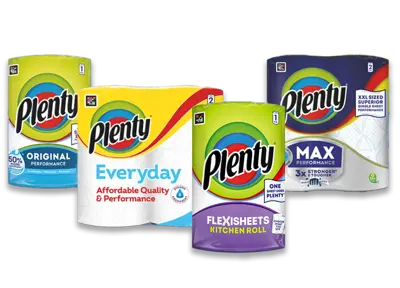428 people found this helpful

The best things in life can get messy – your kitchen included. But there’s mess, and then there’s gunk, germs, bacteria and all-round gross-ness. To avoid all the above, and to ensure your food is less dodgy, more delicious, brush up on your kitchen hygiene. These 10 hygiene rules in the kitchen will help any messy chef when Eggs Benedict turns into Eggs Bin-edict.
Tip
Why not help the whole household remember this list of 10 rules for the kitchen by printing it out and sticking it on the fridge? You could even ask the kids to illustrate it with some colourful pens if they’re feeling creative.
The Food Standards Agency has advice on hygiene requirements for food businesses, and their handy list of the ‘4 Cs’ is relevant to us home cooks, too.1 Keep the following in mind to help prevent common food hygiene issues:
- Cooking
- Cleaning
- Cross-contamination
- Chilling
1. Kitchen hygiene 101: wash hands
Making sure your hands are clean is at the top of the kitchen hygiene rules list. It’s easy for bacteria to be transferred, so wash your hands throughout prepping and cooking food. Regular handwashing is one of the most essential kitchen hygiene rules for kids too, so make sure the whole family knows how to wash their hands properly. Other hand hygiene tips include:
- Avoid wearing rings when you’re busy in the kitchen (they make it more difficult to wash your hands properly, and also collect bacteria and dirt).
- It’s more hygienic to keep your nails short and not wear nail polish.
- If you get a cut on your hands, clean it immediately and pop a plaster on.
On the subject of personal hygiene, it’s also important to tie back long hair when you’re making dishes, as hair can carry germs too. Did you know we each lose about 50 hairs per day?2 Professionals wear hats and hairnets for a reason!
2. Thoroughly cook foods
One of the most important food hygiene rules is to ensure food is cooked properly. If undercooked, harmful bacteria could lead to food poisoning. These rules will help you avoid that:
- Cut into the food to check that it is cooked through.
- Use a food probe thermometer to check meat is cooked to the correct temperature.
- Make sure any reheated food is piping hot.
- Serve cooked food at a minimum temperature of 70 °C (the temperature range from 15 °C to 55 °C is when you get the most rapid multiplication of bacteria).
3. Correct food storage
Proper cooking is only the first of the essential food hygiene rules. Another one of the most important food hygiene rules in the kitchen is safe storage. Correct storage will help keep food safe from chemicals and harmful bacteria, and will help keep contact between air and food to a minimum. These simple tips will help you store food safely:
- Make sure leftovers or open food packets are covered with cling film or kept in a sealed container.
- You also need to use sealed containers for the type of food that’s kept on shelves or in the cupboard, like flour, rice and pasta.
- Don’t put warm food into the fridge. It needs to have cooled first, but should be put in the fridge or freezer as soon as possible (within two hours). Keep this in mind when prepping family meals to freeze!
- Don’t leave food out for more than two hours (that includes cut veg and fruit).
- Place food packages on plates to avoid any juices dripping onto counter tops or fridge shelves – store on the lowest shelf to further help avoid contamination.
- Keep your fridge clear of any items that are out of date.
- Don’t overstuff your fridge (there should be enough room for proper air circulation).
- Get your chilled groceries into the fridge as soon as possible after you buy them (the same goes for frozen items and the freezer).
4. Wipe down counter tops
Wiping kitchen counter tops after every use is one of the easiest (and most essential) basic kitchen hygiene rules. You’ll not only be keeping things clean and tidy, you’ll be stopping the spread of bacteria, too.
Wipe down other high touch-point areas regularly too, like:
- Fridge door
- Knobs and handles on appliances
- Taps
Tip
Maintaining good kitchen hygiene is all about spot-cleaning. Keep a roll of extra absorbent kitchen paper, like Plenty, on hand to quickly mop up spills. It’s strong when wet, too, so it’ll hold together even for scrubbing and wringing-out.
5. Food hygiene rules: don't cross-contaminate
If you’ve ever had food poisoning, you’ll understand why avoiding cross-contamination is high on the list of basic kitchen hygiene rules. You don’t want harmful microorganisms moving from raw food to cooked food, and making you ill. Follow these rules to avoid cross-contamination in the kitchen:
- Use different boards for cutting fish, meat, veg, dairy or bread (different colour boards can help with this).
- Use different utensils for raw and cooked food.
- Never leave edible food next to raw meat.
6. Clean your chopping board after use
Bits of food left on a chopping board will soon breed bacteria, so scrubbing down your board immediately after use is vital to stop them spreading. Quick, easy and essential, cleaning chopping boards is one of the most basic kitchen hygiene rules.
7. Bin basics
Regularly changing your bin is a key aspect of kitchen hygiene. Old food in a bin will soon decompose and bacteria will start to form, along with a stinky-record of the things you’ve cooked in the last week. Check your rubbish on a daily basis to see if it needs taking out, and you’ll avoid having to hold your breath while you tie the bag up.
Bin organisation can not only keep your kitchen organised and tidy but also prevent your regular bin from being filled with stinky, rotting food waste. Many local councils offer a food waste collection service – check with yours today!
But not every bit of waste has to leave the house. Keeping a compost bin in the garden is a fantastic way to turn those vegetable scraps and other organic waste into something useful! Not sure what you should be composting? Just read our handy guide ‘What to put in a compost bin’ and become a composting pro in no time.
Composting gives waste a new purpose, reduces the amount we send to landfill and ultimately can help reduce our carbon footprint! Plus, it's easy! Read our quick guide and get to grips with the sustainable practice. And, to find out exactly what you can and can't compost, click here!
8. Stop grease in its tracks
Have you ever wiped a greasy mark, only to find it has transferred from your cloth to every the microwave, the oven, and your previously-itchy forehead? Try using a piece of absorbent kitchen towel instead – it’ll stop the spread of grease and bacteria.
9. Keep the fridge clean
Ensuring your fridge is clean is one of the top 10 hygiene rules in the kitchen for good reason. Left alone, spills and decaying food can spread their nasties to everything else, so use kitchen paper to spot-clean on a daily basis between thorough fridge-cleaning sessions.
Oh, and do you know that vegetable draw at the bottom of your fridge? That doesn’t have to become a graveyard for questionable and borderline rotten veg! Stick them in the composting bin and let them take on their new life enriching your garden.
While we’re focusing on the fridge, that’s also the place where you should defrost frozen food – not on your counter top. This will help prevent bacteria growth due to a sudden change in temperature.
Tip
Did you know Plenty Original kitchen roll sheets are now certified to be compostable? Now when you’ve finished mopping up life’s little messes you can throw your Plenty kitchen roll sheets in the compost pile. It’s compostable sheets* for your compostable messes!
Want to know more about Plenty’s compostable kitchen roll sheets? Check out the answers to your frequently asked questions.
10. Scrub your sink daily
Your sink is used regularly throughout the day, so it’ll become grimy and covered in bacteria quickly if it’s not kept clean. Again, this is one of those kitchen hygiene rules that doesn’t take much time, but that is well worth doing.
- Give your sink a quick scrub with a scourer and a spritz of kitchen cleaner once a day. Don’t forget the taps!
- Wipe up any pooled water or spillages round the sink with kitchen towel to keep it hygienic between scrubs.
You’ll want to keep your oven hygienic too, so make sure it’s cleaned regularly. The same goes for your hob, grill, microwave and toaster – basically, anything you use to cook food.
Whether it’s following food hygiene rules, changing your bin often or keeping your worktops clean, these basic kitchen hygiene rules will help you protect your family against food poisoning and illness. Now for that deep clean of the kitchen…
Tip
Germs love clinging to cloths and sponges, so when wiping around germy areas, use a fresh sheet of strong kitchen paper, like Plenty and pop it in the bin afterwards. That way, you’ll avoid transferring germs to other surfaces.
*Plenty kitchen towels are certified as home and industrially compostable according to NF T 50-800 and EN14995.
Sources:
1 ‘Food hygiene for your business’, Food Standards Agency; 2018 https://www.food.gov.uk/business-guidance/food-hygiene-for-your-business
2 ‘Food and Kitchen Hygiene’, Canadian Centre for Occupational Heath and Safety https://www.ccohs.ca/oshanswers/prevention/kitchen_hygiene.html
Related articles
How to clean baking trays until they shine
Wish your dull, dirty baking tray could sparkle like new? Learn the best way to clean baking trays with just a little elbow grease in 7 easy steps.
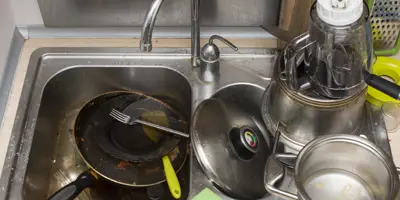
10 rules of basic hygiene (for kids who love to cook)
It’s never too early to teach budding chefs about basic food hygiene and how to prepare food safely. Read on for 10 essential food hygiene rules.

Learn how to clean the microwave with 3 easy methods
Discover the best ways to clean the microwave, including how to clean a microwave with lemon, vinegar, and how to get a clean microwave with baking soda.
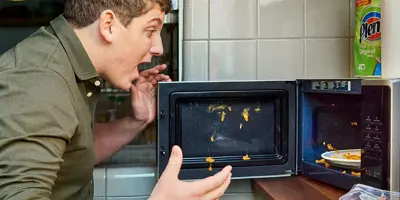
How to clean a deep fat fryer: 10 easy tips
Learn how to clean a deep fat fryer swiftly and safely! These 10 tips show you the best way to clean deep fat fryer interiors and exteriors.
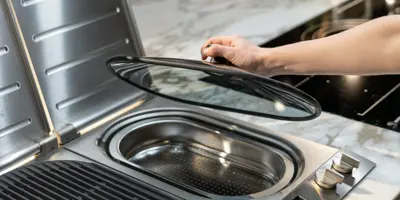
How to clean an oven after not cleaning it for a while
Looking for straight-forward oven cleaning tips? Read this simple step-by-step guide on the best way to clean an oven.
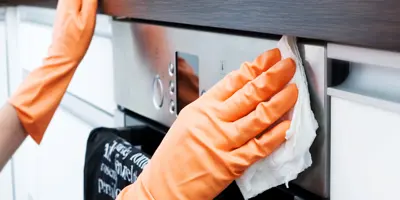
How to clean a fridge when you’re in a hurry
Our guide on how to clean a refrigerator until it’s spick-and-span, inside and out, in less than 30 minutes. Click here to take the challenge!



